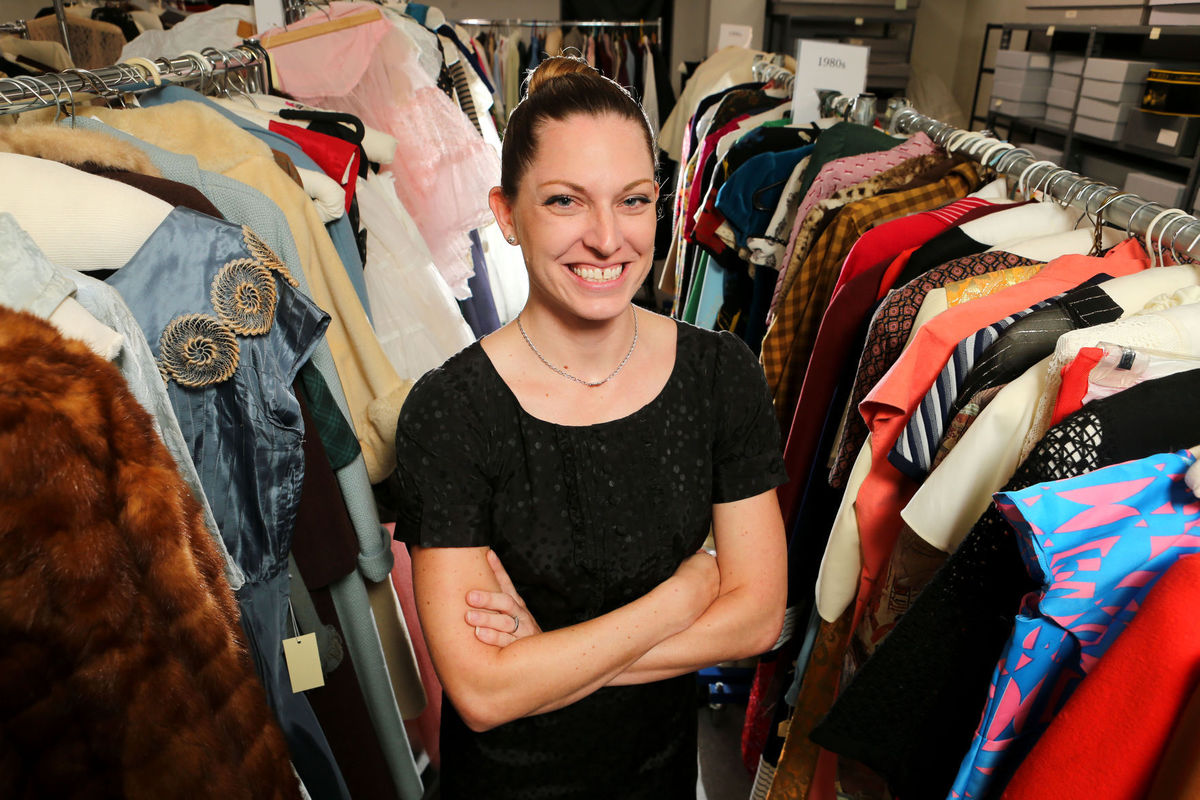
Lori Neuenfeldt (photo by Adam Robison via djournal.com)
By Scott Morris | via Daily Journal
Mississippi State University’s Moore Hall houses a roomful of colorful history.
“We have approximately 2,000 objects,” said Lori Neuenfeldt, instructor and gallery director.
Specifically, the MSU Historic Costume and Textiles Collection preserves clothes, shoes and accessories. The oldest item dates back to the 1840s. Some were for everyday wear, others strictly reserved for special occasions.
“We don’t repair. We preserve them and protect them,” Neuenfeldt said. “We don’t try to bring them back to life. We’re more interested in the stories they have to tell.”
Some might not think of fashion as a serious topic, but it touches every aspect of human life. The differences between a store-bought silk dress and a handmade wool dress can speak to class, economic development, regional trends and down-to-earth realities of human existence.
“All of the garments have been worn by people,” Neuenfeldt said. “They have been lived in.”
In the past, clothes were constructed with the future in mind. A man’s coat or a woman’s dress could be passed down to children and siblings. Every ripped seam required needle and thread, rather than a trip to the department store or mall.
“If we get a hole in a shirt, unless it’s a favorite, favorite shirt, we don’t repair it,” Neuenfeldt said. “Victorians passed clothing down for generations and generations.”
When people first hear about a costume collection, they can get the wrong idea.
“They say, ‘Oh, I like the theater,’” she said. “No, costume is the academic term for historical fashion.”
But there has been theatrical interest. Professors and students from the University of Southern Mississippi traveled to Starkville for close-up views.
“They were interested in how they made those 1890s puffy sleeves,” Neuenfeldt said, holding up an example. “You can feel the horse hair in there that makes this leg-of-mutton-style sleeve.”
The visitors wanted to reproduce clothes for the stage. In the search for historical accuracy, they might use hooks and eyes, which were the norm until the zipper came into wide use during the 1930s.
“It was exciting for me to have them come,” Neuenfeldt said, “because they could elaborate on the construction of the clothing.”
The collection is affiliated with MSU’s fashion design and marketing program, so students can inspect and observe.
“It’s helping me learn the history and construction of clothing,” said Water Valley’s Taylor Anne Trusty, a freshman student worker who puts information about the collection into a searchable database. “I’ve learned fashion repeats itself. We tend to just make small changes to clothes over the years.”
Most changes are cosmetic, but others respond to momentous world events.
“During the 1940s,” Neuenfeldt said, “they had restrictions. People had to give their material to the war effort.”
If given the chance to add one piece to the collection, she might ask for a Christian Dior dress from 1947 or ’48. Dior remains a widely known luxury brand, but the time period is equally important when it comes to telling a story through fashion.
“Post World War II, Christian Dior introduced full skirts and used more yards of fabric than had been used in years,” Neuenfeldt said. “A lot of people saw it and said, ‘This is his way of saying the war was over.’”
Dior had his critics. Europe was devastated by the fighting. The end of open warfare didn’t rebuild homes, bring back jobs and return loved ones.
“Some were offended by the use of the fabric because there was so much poverty, and people were spending money on what many would consider frivolous fashion,” she said. “A Dior would symbolize so much about history.”
The collection has the capacity to surprise, as when visitors marvel at how long it would take to lace up an old-school pair of boots.
It also can offend. Several items incorporate fur, which was considered a symbol of status. Men wore their raccoon coats and women had their mink stoles. Babies even got into the act.
“We have a pair of baby slippers that look like rabbits and have rabbit fur on them,” Neuenfeldt said.
The collection focuses on U.S. items, but there are some international objects, including a pair of silk Chinese binding slippers.
“A female of high status would have her feet bound when she was younger,” Neuenfeldt said. “It would prevent them from growing. Small feet were considered beautiful. A lot of times the foot would grow around it. They would not be able to walk very well. They had to be carried.”
That might seem shocking, but Chinese women aren’t the only ones who underwent pain to attain a cultural ideal of beauty. Tight-fitting corsets are mostly in the past, but high heels are still exacting their price, and many women consider the cost worth it.
“Again, it’s a status symbol,” Neuenfeldt said. “Because you’re wearing high heels, you’re not doing hard labor. It sends a message. People will interpret the things you wear.”
The collection room at Moore Hall has undergone renovations in recent years. The carpet was removed and metal shelving was installed. Windows were covered to keep out natural light that could damage fragile fabrics.
“We have electronic devices that monitor the temperature and the humidity,” she said. “We need to maintain 67 degrees to keep the garments happy.”
Though space is limited, there’s room for more. Neuenfeldt isn’t interested in repeating items, but there are holes in MSU’s colorful collection of history. To make a donation or arrange a tour, go to www.historiccostume.msstate.edu.
Visitors will find themselves within one degree of separation between the present day and nearly 180 years of intimate human history.
“Really,” Neuenfeldt said, “you can study everything from clothing.”